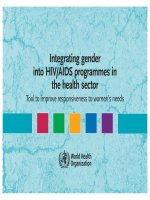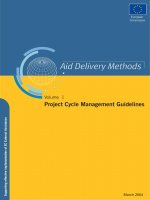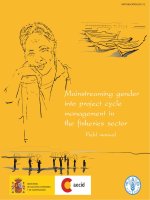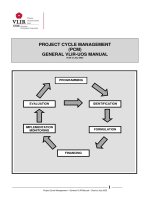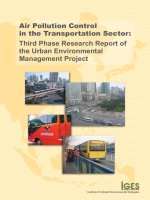Mainstreaming gender into project cycle management in the fisheries sector pdf
Bạn đang xem bản rút gọn của tài liệu. Xem và tải ngay bản đầy đủ của tài liệu tại đây (1.8 MB, 105 trang )
RAP PUBLICATION 2011/15Mainstreaming gender into
project cycle management
in the sheries sector
by
M. C. Arenas and A. Lentisco
FOOD AND AGRICULTURE ORGANIZATION OF THE UNITED NATIONS
REGIONAL OFFICE FOR ASIA AND THE PACIFIC
Bangkok, 2011
RAP PUBLICATION 2011/15
The designations employed and the presentation of material in this information product do not imply the
expression of any opinion whatsoever on the part of the Food and Agriculture Organization of the United
Nations (FAO) or AECID concerning the legal or development status of any country, territory, city or area or
of its authorities, or concerning the delimitation of its frontiers or boundaries. The mention of specic companies
or products of manufacturers, whether or not these have been patented, does not imply that these have been
endorsed or recommended by FAO or AECID in preference to others of a similar nature that are not mentioned.
ISBN 978-92-5-106934-9
All rights reserved. Reproduction and dissemination of material in this information product for educational or
other non-commercial purposes are authorized without any prior written permission from the copyright holders
provided the source is fully acknowledged. Reproduction of material in this information product for resale or
other commercial purposes is prohibited without written permission of the copyright holders.
Applications for such permission should be addressed to:
Chief
Electronic Publishing Policy and Support Branch Communication Division
FAO
Viale delle Terme di Caracalla, 00153 Rome, Italy
or by e-mail to:
© FAO 2011
Design: Sonia Garcia Vaca
For copies write to: Steve Needham
FAO Regional Ofce for Asia and the Pacic
Maliwan Mansion, 39 Phra Atit Road
Bangkok 10200
THAILAND
Tel: (+66) 2 697 4000
Fax: (+66) 2 697 4445
E-mail:
iii
Foreword
There is a global consensus on the importance of addressing gender in development. Yet this
is often neglected when it comes to eld project design and implementation.
Although the sheries sector has long been considered a male domain, the involvement and
contribution of women is far more signicant than often assumed. This lack of understanding
of the complexity of the gender dimension of sheries can result in policies or programmes
failing to create sustainable livelihoods.
To date, there is relatively little guidance or specic recommendations on how to effectively
address gender in the context of small-scale sheries development. FAO fully acknowledges
the importance of addressing gender issues in development projects as a way to promote
gender equity and improve sheries livelihoods. Too often, there is insufcient attention paid to
the gender issues that affect shing communities. There is also a lack of tools and guidance on
how gender issues in such communities can be addressed.
For this reason, the FAO Regional Fisheries Livelihoods Programme for South and Southeast
Asia (RFLP) funded by Spain, has created this eld guide to help practitioners incorporate a
gender perspective into all phases of small-scale sheries development projects.
I am condent this handbook will make an important contribution to help ensure gender
concerns are explicitly recognized and addressed in project activities both in South and
Southeast Asia and beyond.
Hiroyuki Konuma
Assistant Director-General and FAO Regional Representative for Asia and the Pacic
iv
Acknowledgements
This publication has been developed through the valuable input of a wide range of
collaborators. Special thanks go to the participants of the FAO Workshop on Best Practices
for Gender Mainstreaming in the Fisheries Sector held in Siem Reap Cambodia, 2-5 November
2010. Warm thanks also go to the shing communities in Prek Sramoach, Kampong Pluk and
Chong Khneas on Tonle Sap Lake, and Chum Pou Khov in Preah Sihanouk, in Cambodia, the
shing communities from Phu Loc Town, Loc Tri Commune and Hai Tien Village in Thua Thien
Hue Province, Viet Nam, and the shing communities in Lautem and Baucau in Timor-Leste,
for kindly helping eld test this handbook.
v
Table of Contents
Foreword . . . . . . . . . . . . . . . . . . . . . . . . . . . . . . . . . . . . . . . . . . . . . . . . . . . . . . . . . . . . .iii
Acknowledgements . . . . . . . . . . . . . . . . . . . . . . . . . . . . . . . . . . . . . . . . . . . . . . . . . . . . . . . . . . . . .vii
The Regional Fisheries Livelihoods Programme for South and Southeast Asia (RFLP) . . . . . .viii
List of acronyms . . . . . . . . . . . . . . . . . . . . . . . . . . . . . . . . . . . . . . . . . . . . . . . . . . . . . . . . . . . . . . . . . .ix
About the handbook . . . . . . . . . . . . . . . . . . . . . . . . . . . . . . . . . . . . . . . . . . . . . . . . . . . . . . . . . . . . .xi
Chapter 1:
Gender equality in development cooperation . . . . . . . . . . . . . . . . . . . . . . . . . .1
1.1 Rationale . . . . . . . . . . . . . . . . . . . . . . . . . . . . . . . . . . . . . . . . . . . . . . . . . . . . . . . . . . . . . . . . . . . . . . .2
1.1.1 Poverty and gender . . . . . . . . . . . . . . . . . . . . . . . . . . . . . . . . . . . . . . . . . . . . . . . . . . . . . . . . . .2
1.1.2 Human rights and gender . . . . . . . . . . . . . . . . . . . . . . . . . . . . . . . . . . . . . . . . . . . . . . . . . . . .2
1.2 Key concepts . . . . . . . . . . . . . . . . . . . . . . . . . . . . . . . . . . . . . . . . . . . . . . . . . . . . . . . . . . . . . . . . . .3
1.3 Gender mainstreaming . . . . . . . . . . . . . . . . . . . . . . . . . . . . . . . . . . . . . . . . . . . . . . . . . . . . . . . . .9
1.3.1 What is gender mainstreaming? . . . . . . . . . . . . . . . . . . . . . . . . . . . . . . . . . . . . . . . . . . . . . .9
1.3.2 Approaches to mainstreaming gender equality . . . . . . . . . . . . . . . . . . . . . . . . . . . . . . . .11
Chapter 2:
Women in sheries . . . . . . . . . . . . . . . . . . . . . . . . . . . . . . . . . . . . . . . . . . . . . . . .15
2.1 The role of women in sheries . . . . . . . . . . . . . . . . . . . . . . . . . . . . . . . . . . . . . . . . . . . . . . . . . . .15
2.2 Women in sheries in Southeast Asia . . . . . . . . . . . . . . . . . . . . . . . . . . . . . . . . . . . . . . . . . . . .16
2.3 Recommendations for empowering women in sheries . . . . . . . . . . . . . . . . . . . . . . . . . . . . .20
Chapter 3:
Tools for mainstreaming gender equality in development cooperation
projects . . . . . . . . . . . . . . . . . . . . . . . . . . . . . . . . . . . . . . . . . . . . . . . . . . . . . . . . .27
3.1 General considerations . . . . . . . . . . . . . . . . . . . . . . . . . . . . . . . . . . . . . . . . . . . . . . . . . . . . . . . .27
3.2 Activity analysis . . . . . . . . . . . . . . . . . . . . . . . . . . . . . . . . . . . . . . . . . . . . . . . . . . . . . . . . . . . . . . .30
vi
3.3 Access to and control over resources and benets . . . . . . . . . . . . . . . . . . . . . . . . . . . . . . . . .33
3.4 Gender needs . . . . . . . . . . . . . . . . . . . . . . . . . . . . . . . . . . . . . . . . . . . . . . . . . . . . . . . . . . . . . . . .37
3.5 Mapping the factors that inuence gender dynamics . . . . . . . . . . . . . . . . . . . . . . . . . . . . . . .39
3.6 Gender sensitive indicators . . . . . . . . . . . . . . . . . . . . . . . . . . . . . . . . . . . . . . . . . . . . . . . . . . . . .41
Chapter 4:
Mainstreaming gender in project cycle management . . . . . . . . . . . . . . . . . . .47
4.1 Project Cycle Management (PCM) . . . . . . . . . . . . . . . . . . . . . . . . . . . . . . . . . . . . . . . . . . . . . .47
4.1.1 What is a project? . . . . . . . . . . . . . . . . . . . . . . . . . . . . . . . . . . . . . . . . . . . . . . . . . . . . . . . . . .47
4.1.2 Project Cycle Management (PCM) . . . . . . . . . . . . . . . . . . . . . . . . . . . . . . . . . . . . . . . . . . .47
4.1.3 The Logical Framework Approach (LFA) . . . . . . . . . . . . . . . . . . . . . . . . . . . . . . . . . . . . . . 49
4.1.4 Merging PCM and Logframe Approach . . . . . . . . . . . . . . . . . . . . . . . . . . . . . . . . . . . . . . . .50
4.1.5 Phases in project management resulting from merging PCM and LFA . . . . . . . . . . . .51
4.2 Assessing gender equality at all project stages. . . . . . . . . . . . . . . . . . . . . . . . . . . . . . . . . . . . . .62
4.2.1 Identication and formulation . . . . . . . . . . . . . . . . . . . . . . . . . . . . . . . . . . . . . . . . . . . . . . . .62
4.2.1.1 Participation/stakeholder analysis . . . . . . . . . . . . . . . . . . . . . . . . . . . . . . . . . . . . . . . . . 64
4.2.1.2 Problems analysis . . . . . . . . . . . . . . . . . . . . . . . . . . . . . . . . . . . . . . . . . . . . . . . . . . . . . . . 65
4.2.1.3 Analysis of objectives . . . . . . . . . . . . . . . . . . . . . . . . . . . . . . . . . . . . . . . . . . . . . . . . . . . . 67
4.2.1.4 Analysis of alternatives . . . . . . . . . . . . . . . . . . . . . . . . . . . . . . . . . . . . . . . . . . . . . . . . . . 67
4.2.1.5 The logframe matrix . . . . . . . . . . . . . . . . . . . . . . . . . . . . . . . . . . . . . . . . . . . . . . . . . . . . 67
4.2.2 Implementation and monitoring . . . . . . . . . . . . . . . . . . . . . . . . . . . . . . . . . . . . . . . . . . . . . . 71
4.2.3 Evaluation . . . . . . . . . . . . . . . . . . . . . . . . . . . . . . . . . . . . . . . . . . . . . . . . . . . . . . . . . . . . . . . . .73
Appendices
Appendix 1: Step-by-step guide to carry out eld work in a shing community . . . . . . . . . . .77
Appendix 2: Glossary of Terms . . . . . . . . . . . . . . . . . . . . . . . . . . . . . . . . . . . . . . . . . . . . . . . . . . . . .83
References . . . . . . . . . . . . . . . . . . . . . . . . . . . . . . . . . . . . . . . . . . . . . . . . . . . . . . . . . . . . . . . . . . . . .89
vii
The Regional Fisheries Livelihoods Programme for South and Southeast Asia (RFLP)
The Regional Fisheries Livelihoods Programme for South and Southeast Asia (RFLP) sets out to
strengthen capacity among participating small-scale shing communities and their supporting
institutions in Cambodia, Indonesia, the Philippines, Sri Lanka, Timor-Leste and Viet Nam. By
doing so the RFLP seeks to improve the livelihoods of shers and their families while fostering
more sustainable sheries resources management practices.
The four-year (2009 - 2013) RFLP is funded by the Kingdom of Spain and implemented by the
Food and Agriculture Organization of the United Nations (FAO) working in close collaboration
with national authorities in participating countries.
The RFLP recognizes that it is necessary to pay attention to gender concerns throughout
the entire project lifecycle, because this is crucial to the improvement of livelihoods and the
reduction of vulnerability of shing communities.
To support this recognition and to contribute to the regional sharing of knowledge on gender
concerns in the sheries sector at eld level, the RFLP has developed this eld handbook
on mainstreaming gender in all phases of the project life cycle, thereby contributing to the
promotion of gender equity and the improvement of sheries livelihoods.
For more information on the RFLP see www.rp.org
viii
List of acronyms
ADB Asian Development Bank
AUSAID Australian Agency for International Development
CEDAW Convention on the Elimination of all forms of Discrimination against Women
EU European Union
FAO Food and Agriculture Organization of the United Nations
FWCW Fourth World Conference on Women
ILO International Labour Organization
GAD Gender and Development
LFA Logical Framework Approach
MDGs Millennium Development Goals
NGOs Non-Governmental Organisations
OECD Organization for Economic Co-operation and Development
OVI Objectively Veriable Indicators
PCM Project Cycle Management
PFA Beijing Platform of Action
RFLP Regional Fisheries Livelihoods Programme
SEAGA Socio-Economic and Gender Analysis Programme
SOV Source of Verication
UN United Nations
UNDP United Nations Development Programme
UNESCO United Nations Educational, Scientic and Cultural Organization
UNFPA United Nations Population Fund
UNICEF United Nations Children’s Fund
UNIFEM United Nations Development Fund for Women
WID Women in Development
ix
About the handbook
This manual has been prepared to facilitate gender analysis and project planning in sheries
development projects. It is intended to be a toolkit to help project managers and implementing
counterparts (such as extensionists, government and non-government eld workers, and
private- and public-sector development consultants, community organizers and leaders of
local groups), to facilitate the integration of gender issues into the project cycle.
The handbook is structured as follows:
Chapter one: provides the rationale, concepts and approaches relative to mainstreaming
gender equality into development cooperation.
Chapter two: presents an overview of the role of women in the sheries sector in Southeast Asia,
the problems they face and possible empowerment opportunities.
Chapter three: provides tools for gender analysis in sheries development projects and
guidance on gender sensitive indicators.
Chapter four: provides the link for mainstreaming gender at various stages of the project cycle.
An overview of the Project Cycle Management is presented in section 4.1.
For further reading, a bibliography of relevant texts as well as website references are presented
at the end of the document.
A work in progress…
The contents of this handbook have been developed with reference to a wide range of
resources. The tools have been tested in the eld and both the tools and handbook have
received feedback from a number of practitioners and experts.
Nevertheless, the Regional Fisheries Livelihood Programme recognizes the importance of
continually updating this publication to incorporate the experiences and suggestions of users.
We would therefore like to encourage users to provide comments and feedback to Steve
Needham, RFLP Information Ofcer at
Chapter 1:
Gender equality in development cooperation
Gender equality and the empowerment of women are human rights that lie at the heart of
development. When women and men have relative equality, economies grow faster, children’s
health improves and there is less corruption. Gender equality helps reduce the root causes of
poverty and vulnerability while contributing to sustainable growth and the achievement of the
Millennium Development Goals (MDGs).
The eight MDGs which were adopted by the international community in 2000 set a variety of
development targets for 2015. All eight touch on essential aspects of women’s well-being, and
in turn, women’s empowerment is critical for achieving the goals.
The third goal is specically directed towards the promotion of gender equality and empower-
ment of women with the target to eliminate gender disparity in all levels of education no later
than 2015. Meanwhile the fth MDG focuses on maternal mortality and universal access to
reproductive health.
In 2003 the United Nations Development Programme (UNDP) Human Development Report
suggested that if rich and poor countries worked hand in hand they could lift millions out of
severe poverty. However, the report acknowledged that unless women’s capabilities were im-
proved and gender equality increased, the MDGs would not be achieved.
During recent years progress has been made in many areas, yet meeting the MDGs remains a
considerable challenge.
The need therefore remains for the donor community and developing nations alike to place
increased emphasis upon the promotion of gender equality and women’s empowerment, in-
cluding in the sheries sector. Recognizing women as a key driver of development and focusing
efforts upon them will ensure long lasting benets for society at large.
Six out of ten of
the world’s poorest
people are
women and girls.
Worldwide,
24 percent
of girls of primary
school age are
still not attending
school, compared
with 16 percent
of boys.
In developing
countries, the adult
literacy rate for
men is 84 percent
and 70 percent
for women.
2
1.1 Rationale
1.1.1 Poverty and gender
The primary and overarching objective of development cooperation is the eradication of
poverty in the context of sustainable development. Poverty, however, is understood not simply
as a lack of income and nancial resources, but also as encompassing the notion of
inequalities
in access to and control over the material and non-material resources of any particular society.
These material and non-material benets include rights, political voice, employment,
information, services, infrastructure and natural resources. An important determinant of
inequality in access to and control over societal resources and benets is
gender
.
1.1.2 Human rights and gender
Gender equality and non-discrimination on the basis of sex are fundamental human rights,
recognised by a number of international legal instruments and declarations and enshrined in
most national constitutions. However, often national laws, customary law or societal structures
result in differential treatment of women and men or boys and girls. Most human rights
instruments are ‘gender-neutral’ in that they guarantee that all citizens will be treated without
discrimination by the State, but that guarantee alone is insufcient to address inequalities
which already exist.
The Convention on the Elimination of All Forms of Discrimination Against Women (CEDAW)
moves beyond statements guaranteeing equality and sets out measures aimed at achiev-
ing substantive equality in all elds and across all sectors. CEDAW thus provides a universal
framework for rights-based development’.
1
1
See Kit on the Convention on the Elimination of All Forms of Discrimination Against Women (1979) prepared by UNICEF/UNIFEM
(1995).
3
1.2 Key concepts
Sex refers to the biological and genetic differences between males and females which naturally
can not be changed. It refers to physical attributes pertaining to a person’s body contours,
features, genitals, hormones, genes, and reproductive organs.
Biological differences between males and females:
Gender has been dened as ‘a concept that refers to the social differences, as opposed to the
biological ones, between women and men, which have been learned, are changeable over
time and have wide variations both within and between cultures’.
2
Gender affects the relationship between women and men in the family and society. It relates to
the distribution of power, position, class and responsibility. These are determined by society
and can also be changed by society.
Differences between sex and gender
3
SEX GENDER
BIOLOGICAL FACTORS FROM BIRTH SOCIAL FACTORS, NOT FROM BIRTH
CAN NOT BE CHANGED CAN BE CHANGED
E.g.: E.g.:
- Only women can give birth - Men and women can do housework
- Only men can have male genitalia - Women and men can be teachers, engineers,
- Only women can be pregnant etc.
drivers etc.
- Women and men can be leaders and managers
Female Male
Has a uterus, can become pregant, can give No uterus, cannot be pregnant,
birth cannot give birth
Female genitalia Male genitalia
Can breastfeed Cannot breastfeed
No beard Having beard
2
One Hundred Words for Equality: A glossary of terms on equality between women and men (DG Employment and Social Affairs, 1998),
/>3
Taken from
Introductory Module: Gender Concept for Community Fisheries Management
. CBRMN. July 2009.
4
Sex roles Gender roles
Same for all societies and universal Differ from one society to another society
Can not be changed according to history Can be changed according to history
Having only one role for each sex Roles for both sexes
Biologically determined Dened by culture and society - Not biologically determined
Gender roles are the roles both sexes are expected to fulll in a society as dened by their virtue
of being female or male. The role of a mother and father, for example, incorporates the right
and the obligation to care for the children and to provide a living for the family.
Both sets of roles are shaped by a multiplicity of social, economic, political, cultural and other
factors, and will change with changes in these formative inuences. For example, if many of the
male adults in a society are absent for war or for work for a long period of time the roles of
women will inevitably change.
Changes in gender roles can be spontaneous or can result from planned policies and
interventions, such as development programmes. As development programmes create changes
(in one or several dimensions) they inevitably impact upon gender roles and relationships,
whether or not that is their stated objective.
Differences of sex roles and gender roles’:
4
Gender relations have been described as ‘the relationship and unequal power distribution
between women and men which characterise any specic gender system
’
.
5
Women’s and men’s respective gender roles are not only different, but are often also unequal
in weight, power and value.
Gender inequality shows itself in many ways, but can be summarised as unequal access to
and control over the various material and non-material resources and assets of their society.
In most societies the woman’s role is usually the inferior one in the relationship. Meanwhile
women very rarely have equal access to power and decision-making structures. Inequality
relates to lack of access to rights, assets and decision-making; and to lack of control over various
facets of one’s life.
4
Taken from
Introductory Module: Gender Concept for Community Fisheries Management
. CBRMN. July 2009.
5
One Hundred Words for Equality. op. cit
44
5
Gender equity refers to the process of fair and just treatment of women and men to reach
gender equality. To ensure fairness and justice, measures must be put in place to compensate
for the historical and social disadvantages that prevent women and men from sharing a level
playing eld. One example of measures is the provision of leadership training for women or
establishing quotas for women in decision-making positions.
EQUITY LEADS TO EQUALITY
Equality of result can not be achieved without applying gender equity principles
Gender equality does not mean that women and men should be ‘the same’, or that there must
be equal numbers of men and women or of girls and boys in all activities. It does mean that
women and men enjoy the same status within a society, being free to develop their personal
abilities, and make choices without the limitations set by strict gender roles’.
6
It can be said that gender equality means equal treatment of women and men in laws and
policies, and equal participation, access to resources and services (e.g. justice, education, health)
within families, communities and society at large.
6
One Hundred Words for Equality. op. cit
55
6
Gender equality is dened in many different ways. One way to approach this concept is by
breaking it down into ve main components’:
7
rights
opportunities
value
situation and outcome
agency
Rights
Gender equality means that both men and women should have the same rights, and be equal
before the law. (This is known as “de jure,” or formal gender equality). These rights are
articulated in international conventions, such as the Convention to Eliminate All Forms of
Discrimination Against Women (CEDAW), in national constitutions, and in legislation and other
documents. Granting both men and women the same legal rights is the cornerstone of building
a society in which men and women enjoy equality.
Opportunities
While the provision of equal rights can establish “de jure” (legal) equality between men and
women, true gender equality requires more than legal guarantees. In order to ensure “de facto”
(practical) equality between men and women, these laws need to be put into practice. In
reality, many social, cultural, economic, and other barriers exist that prevent women, and men
as well, from being able to fully enjoy their legal rights to equality.
7
UNDP. Gender Mainstreaming in Practice: A Toolkit. 2007.
6
7
For this reason, gender equality must also be about equality of opportunity. In other words,
neither men nor women should face any barriers to learning, working, or participating in
politics, the community or family simply because of their sex. Both sexes should have the same
opportunities to access employment, resources, knowledge and information, and services, and
to live healthy and happy lives. Men and women should likewise be in a position to be able to
make genuine choices about their own work and welfare, and should have equal opportunities
to make and inuence decisions about themselves, their families, and their communities.
Even in cases where equal opportunities are formally ensured through law and policies,
men and women may still encounter barriers to enjoying truly equal opportunities. The
practical operation of institutions (ranging from the household to the state), attitudes
and stereotypes about gender roles and relations as well as traditional and cultural
practices all greatly inuence the existence of these opportunities.
Value
Thirdly, gender equality also means that men’s and women’s contributions to the family,
society, and community should be valued equally, even though those contributions may be
different. These contributions include men’s and women’s work (paid and unpaid) and
their contributions of non-monetized or immaterial resources such as time, care, skills, and
knowledge. Attributing equal value to men’s and women’s resources can sometimes be
achieved through law and policy, but it also requires that we shift our attitudes and actions.
7
8
Situation and outcome
Some critics of gender equality initiatives have pointed out that striving for equality of
situation or outcome means that we are limiting men’s and women’s choices. Their argument
states that even if men and women have the same rights and opportunities, they may not
make the same choices, and therefore it is wrong to expect that the end result for men and
women should be the same.
This criticism raises an important point: part of gender equality should be to increase the choices
of men and women, and certainly not to constrain these choices in any way. And, yes, it is true
that men and women can and do make different choices. However, what this criticism does not
attend to is the way in which individual choices are overwhelmingly determined by the context
in which these choices are made. In most cases, men and women cannot make the same choices
because of the deeply engrained social, economic, cultural, and legal contexts in which they live
and work.
For example, in societies where violence against women is implicitly or explicitly tolerated
(which is unfortunately still too often the case all around the globe), women are not able to
make real choices. The threat of violence will always constrain them.
Agency (the power of individuals)
The nal but equally important component of gender equality is agency. While the rst four
components for the most part consider the social, economic, cultural, legal and other contexts
in which men and women live, they might leave the impression that gender equality is
something that is simply “given” to us by the state or society. Although rights, opportunities, and
value might be conferred through institutions and decision makers, we also need to stress that
gender equality is something that men and women can claim through their actions and voice.
In summary: “Gender equality” is not a one-dimensional phenomenon. It is rather a complex
constellation of rights, opportunities, value, situation, and agency. Each of these aspects is
intimately connected to the others.
9
1.3 Gender mainstreaming
1.3.1 What is gender mainstreaming?
In 1997, the Economic and Social Council of the General Assembly (ECOSOC), adopted gender
mainstreaming as the methodology by which the entire United Nations system would work
towards the advancement of women and gender equality goals:
“Mainstreaming a gender perspective is the process of assessing the implications for women
and men of any planned action, including legislation, policies or programmes, in all areas and
at all levels. It is a strategy for making women’s as well as men’s concerns and experiences an
integral dimension of the design, implementation, monitoring and evaluation of policies and
programmes in all political, economic and societal spheres so that women and men benet
equally and inequality is not perpetuated. The ultimate goal of mainstreaming is to achieve
gender equality”
.
8
The key points to note are that:
- First, the interdependent or complementary roles of men and women are recognised,
so that one cannot be changed without also affecting the other;
- Second, that gender issues are not conned to one sector but must be addressed across
the board;
- Third, that gender issues are not confined to the population of programme
“beneficiaries” but must be addressed also at macro (policy) and meso
(institutional/delivery systems) levels;
- Fourth, that they must be addressed at every stage in the programme cycle, beginning
with identification and formulation, and continuing through implementation,
monitoring and evaluation phases.
8
The Report of the Economic and Social Council for 1997. United Nations, 1997.
Gender
mainstreaming is
not only a
question of social
justice but is
necessary for
ensuring equitable
and sustainable
human
development.
The long-term
outcome of
gender
mainstreaming
will be the
achievement of
greater and more
sustainable
human
development for
all.
10
10
11
1.3.2 Approaches to mainstreaming gender equality
From Women in Development (WID) to Gender and Development (GAD)
9
The current approach to gender and development has been evolving gradually since the 1970s.
The UN International Year of Women (1975) and the International Women’s Decade (1976-85)
saw the establishment of women’s ministries in many countries and the adoption of Women in
Development (WID) policies by donor agencies, governments and NGOs. The main aim of WID
was to integrate women into economic development by focusing on income-generating
projects for women.
Most of these projects achieved little success as they ignored the underlying structural
inequalities in such areas as land ownership, access to markets, credit and information.
The Gender and Development (GAD) approach originated among researchers and
implementers in the mid 1970s and focused on the ways in which development affects existing
gender relations between men and women and vice versa. GAD advocates criticised the WID
approach for treating women as a homogeneous category, and emphasised the inuence on
development outcomes of differences in class, age, marital status, religion and ethnicity as well
as gender. Proponents of GAD distinguished between practical gender needs i.e. needs for items
which would improve women’s lives within their existing roles (e.g. more efcient cooking
stoves), and strategic gender needs which must be met if women are to be enabled to take on
new roles and to become empowered (e.g. increased access to education and information,
legislative changes, representation in decision-making bodies).
The Fourth World Conference on Women (FWCW), held in Beijing in September 1995, ‘was
groundbreaking in shifting the discourse from Women in Development (WID) to Gender and
Development (GAD)’. The term ‘gender mainstreaming’ also came into widespread use with
the adoption of the Beijing Platform for Action (PFA) at the close of that conference.
9
Adapted from Janet Henshall Momsen, Gender and Development, 2004.
12
Key steps in gender mainstreaming
In order to mainstream gender equality in development cooperation programmes and related
activities a number of steps are essential:
- Statistics disaggregated by sex and qualitative information on the situation of women and
men must be obtained for the population in question. This information is required not only
at project/programme beneciary level, but also at the macro and meso levels.
- A gender analysis should be conducted with regard to the gendered division of labour,
access to and control over material and non-material resources, the legal basis for gender
equality/inequality; political commitments with respect to gender equality; and the culture,
attitudes and stereotypes which affect all preceding issues. Gender analysis should be
conducted at the micro, meso and macro levels.
- Gender analysis of a programme or project concept should reveal whether gender equality
objectives are articulated in the initial idea, whether or not the planned activity will
contribute to or challenge existing inequalities and whether there are any gender issues
that have not been addressed.
- During the identication and formulation phases, gender analysis contributes to the
identication of entry points for actions that will be needed in order to meet gender
equality objectives.
- A gender-sensitive monitoring and evaluation system should also be in place from the design
phase onwards, including the establishment of indicators to measure the extent to which
gender equality objectives are met and changes in gender relations achieved.
12
13
Gender analysis
Gender analysis is the systematic attempt to identify key issues contributing to gender
inequalities so that they can be properly addressed. Gender analysis provides the basis for
gender mainstreaming and is described as ‘the study of differences in the conditions, needs,
participation rates, access to resources and development, control of assets, decision-making
powers, etc., between women and men in their assigned gender roles’.
10
Gender analysis is also necessary to determine whether specic actions are needed for women
or men, in addition to mainstreaming activities.
Gender analysis should be conducted at all levels, from the grass roots through intermediate
levels such as service delivery systems to the highest political levels, and across all sectors and
programmes of development cooperation.
A number of analytical frameworks and tools for gender analysis are
included in Chapter Three.
10
One Hundred Words for Equality, op. cit.
13


